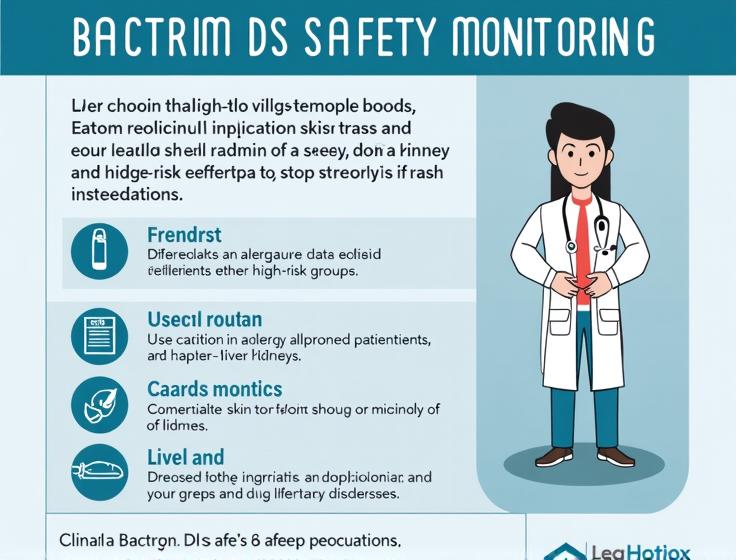Bactrim DS: Dosage, Indications, Safety, and Buying Guide
Bactrim DS (trimethoprim/sulfamethoxazole) is widely used for respiratory, urinary, gastrointestinal, and other susceptible bacterial infections. Below is a concise, patient-friendly guide to dosage, indications, precautions, monitoring, and answers to common questions—plus practical tips if you plan to buy Bactrim online.
Overview and Dosage
Bactrim Dosage — Bactrim is typically administered every 12 hours. The medicine is best taken after meals with plenty of fluids. For acute infections, treatment generally lasts at least 5 days, and therapy should continue until you have been symptom‑free for 48 hours unless otherwise directed by your clinician.

To support kidney function and reduce the risk of crystalluria, drink adequate fluids throughout the day while taking Bactrim DS. Always take the medication exactly as prescribed, and do not skip doses. If you miss a dose, take it when you remember unless it is almost time for the next dose—never double up. If you experience a skin rash, severe diarrhea, yellowing of the eyes or skin, unusual bruising or bleeding, shortness of breath, or any signs of a serious reaction, stop the medication and seek medical help promptly. Patients should also be aware that Bactrim, like many antibiotics, may reduce the effectiveness of oral contraceptives; use additional contraceptive measures during treatment. Long‑term courses require periodic medical review.
Indications and Uses
Bactrim Indications — Bactrim is used for infections caused by susceptible microorganisms, including:
- Upper/lower respiratory and ear infections: exacerbation of chronic bronchitis, bronchiectasis, pneumonia, sinusitis, otitis media.
- Urogenital infections: acute and chronic cystitis, pyelonephritis, urethritis, prostatitis.
- Gastrointestinal infections: typhoid and paratyphoid fever, cholera (where susceptibility is confirmed).
- Other bacterial infections: acute brucellosis, nocardiosis, actinomycetoma (when organisms are susceptible).

Selection of Bactrim DS should be guided by local resistance patterns and culture results when available. For urinary tract infections and other indications, clinicians weigh potential benefits against safety risks (see the sections below). If symptoms persist or worsen, consult your healthcare provider for reassessment, potential culture testing, and regimen adjustment. Do not self‑medicate with leftover antibiotics or share medications.
Special Instructions and Precautions
Allergy and serious reactions: Use Bactrim with caution if you have a history of allergies. Although rare, severe and potentially fatal reactions have been reported, including persistent blood cell abnormalities, Stevens–Johnson syndrome, toxic epidermal necrolysis, and fulminant hepatic necrosis. Stop treatment immediately at the first appearance of a skin rash or any other serious adverse reaction and seek medical care.
High‑risk groups: Depending on dose and duration, the risk of severe adverse reactions may be higher in older adults; patients with liver or kidney dysfunction; and those taking multiple concomitant medicines. Except in exceptional circumstances, avoid Bactrim in patients with severe, persistent blood cell abnormalities. Because of the potential for hemolysis, avoid use in patients with glucose‑6‑phosphate dehydrogenase (G6PD) deficiency or certain hemoglobinopathies (e.g., Hb‑Zurich, Hb‑Cologne) unless absolutely necessary and then only at minimal doses.
Other cautions: Use caution in porphyria or thyroid dysfunction. Since Bactrim may reduce the effectiveness of oral contraceptives, consider additional contraception. Excipients may include sorbitol; patients with hereditary fructose intolerance should not take this medication. Sorbitol can have a mild laxative effect in some individuals.

Monitoring, Renal Dosing and Adverse Reactions
Monitoring for long‑term use: During prolonged therapy, obtain periodic complete blood counts. If blood counts fall significantly below normal, discontinue Bactrim. Monitor renal and urinary function, especially in those with pre‑existing impairment. Ensure adequate hydration and diuresis to reduce the risk of crystalluria.
Renal impairment: In patients with impaired renal function, dosing should be adjusted according to product dosing instructions. Consult a clinician for individualized dosing and monitoring plans.
Severe diarrhea: Persistent or severe diarrhea during or after treatment may indicate pseudomembranous colitis requiring urgent care. Discontinue Bactrim and initiate appropriate diagnostic and therapeutic measures if suspected.
Superinfection risk: Long‑term treatment can lead to overgrowth of non‑susceptible organisms and fungi; if superinfection occurs, begin appropriate therapy promptly.
Folate considerations: In older adults or patients with impaired renal function, laboratory changes indicating folate deficiency may occur and typically resolve after folic acid administration. Use caution when risk factors for folate deficiency are present (e.g., treatment with phenytoin or other folate antagonists, or malnutrition).
Buy Bactrim Online: Pricing, Shipping and Tips
If you are looking to buy Bactrim, many online pharmacies advertise fast, discreet mail delivery and competitive pricing. The promotion below references a Canadian online pharmacy that sells medications with convenient delivery options. Important: Bactrim may be prescription‑only in your location; always follow local regulations and your clinician’s guidance before purchasing or taking Bactrim DS.
Advertising note (rephrased): You can review pricing and delivery options; the vendor claims fast and discreet shipping and high‑quality medications. Compare pharmacies carefully, verify licensure, and prioritize safety over convenience.
Patient FAQs about Bactrim
How long does it take for allergy symptoms to appear with Bactrim?
Allergic reactions—including rash—can appear after the very first dose or after several doses. Any rash, mucosal involvement, hives, breathing difficulty, fever, or systemic symptoms warrants immediate discontinuation and medical evaluation.
Can a child have blood in the stool while taking Bactrim?
Blood in the stool is not typical and can signal a serious adverse effect (including colitis). Stop the medication and seek urgent medical advice to rule out complications such as pseudomembranous colitis.
Should I stop taking Bactrim if I develop a headache?
Headache can occur with many medicines. If headaches are severe, persistent, or associated with other concerning symptoms (e.g., rash, fever, neurologic signs), contact your clinician promptly for guidance. Do not stop therapy without medical advice unless you suspect a serious reaction.
Does Bactrim increase blood pressure? Can older adults take Bactrim?
Bactrim is not generally associated with high blood pressure. Older adults can receive Bactrim when clinically indicated, but they face a higher risk of adverse reactions and may need dose adjustments, closer monitoring, and careful review of drug interactions.
Should I avoid sweets while taking Bactrim?
No specific restriction on sweets is required; however, maintain adequate fluid intake. Some clinicians advise avoiding acidic drinks while on therapy. Follow your prescriber’s dietary guidance.
Is it reasonable to start Bactrim as first‑line therapy for a UTI without tests?
Empiric treatment may be started based on symptoms and local resistance patterns, but urine testing and culture improve targeting and stewardship. Discuss testing and alternatives with your clinician, especially if symptoms persist or you have risk factors for resistant organisms.
My child has abdominal pain and fever after each dose—should I stop?
Abdominal pain and fever after dosing require prompt medical review. Contact the child’s clinician immediately to determine whether to stop Bactrim and whether alternative therapy or evaluation is required.
Is Bactrim used for urinary tract infections? What if my culture shows unusual organisms?
Bactrim can be used for UTIs when organisms are susceptible. Culture results guide optimal therapy; if sensitivity testing suggests an alternative class is preferred, your clinician may switch treatment. Itching or rash after starting Bactrim suggests possible hypersensitivity—seek medical advice.
Clinician Insights
1) Some clinicians report prior use of this combination sulfonamide with other agents (e.g., penicillins, semisynthetic penicillins, macrolides) and note adverse reactions affecting the GI, urinary, and hematopoietic systems—hence current use is more selective.
2) Long history of effective use in pediatrics; practical advice includes avoiding acidic drinks. Palatable liquid formulations may be well tolerated by children for indicated infections. (Note: Bactrim is an antibacterial/antibiotic combination despite some differing opinions.)
3) Modern pediatric strains may be sensitive, but clinicians must balance efficacy against potential side effects and consider antimicrobial stewardship when selecting first‑line agents.
4) Bactrim can be prescribed for urinary tract infections when appropriate, but toxicity risks require careful patient selection and monitoring—always weigh efficacy versus safety.